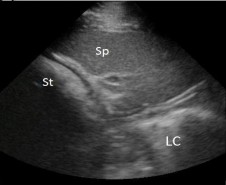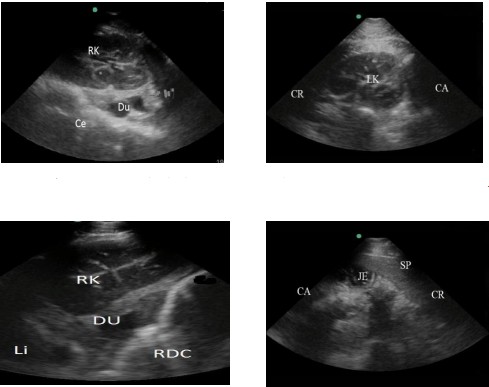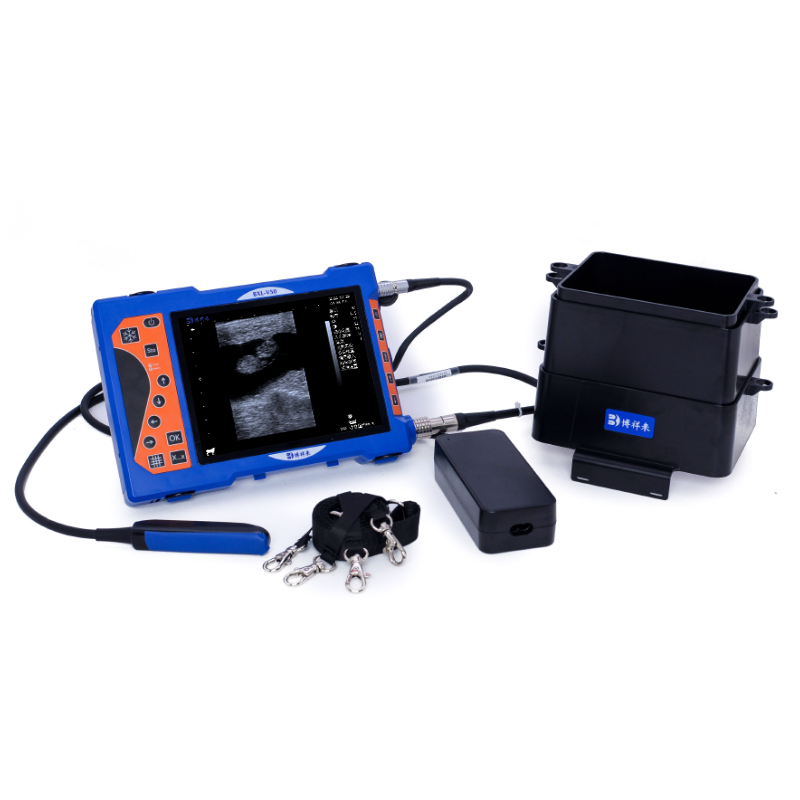Perform abdominal ultrasound examination on 18 female Arabian horses aged 3-5 years old, without shearing, but soaking the hair in isopropanol to improve contact. Scan the stomach from the left side between the 8th or 9th to 12th or 13th intercostal spaces (ICS). Inspect the duodenum from the right side at the 16th and 17th intercostal spaces adjacent to the ventral side of the kidney. The jejunum is usually unimaginable. Imaging of the cecum along the dorsal and caudal walls of the right abdomen. Along the body wall and abdomen, the large colon is usually visible in most parts of the abdomen. Scan the small colon on the dorsal side of the left ventral colon (LVC). Scan the liver ventral to lung margin from the 6th to 15th intercostal space along the right side of the abdomen and from the 6th to 9th intercostal space along the left side of the skull ventral abdomen. Scan the spleen along the left side of the abdomen near the body wall from the 8th or 9th intercostal space to the 17th intercostal space. Scan the right kidney from the 14th to 17th intercostal space. The left kidney was scanned in the 17th intercostal space and lumbar paravertebral fossa. Bladder transrectal imaging.
Location of horse abdominal ultrasound examination
Animal B-ultrasound examination is a non-invasive real-time imaging method with very few potential complications, and it was quickly regarded as an invaluable asset for horse diagnostic imaging. There are many potential applications now, including abdominal ultrasound examination. Large scale structures that are relatively difficult to access using other diagnostic techniques such as radiography and endoscopy. Laparoscopic examination is a valuable diagnostic tool, although the required expertise and equipment limit its availability in specialized centers.
Ultrasound examination allows for rapid and non-invasive examination of the internal organs of the horse's abdomen, some of which cannot be examined by any other method. Ultrasound examination can also provide some evaluation of intestinal activity and luminal contents.
The purpose of this work is to encourage the use of ultrasound as a routine procedure for examining intra-abdominal structures in Arabian horses and to establish a standard reference for the appearance of normal intra-abdominal structure images in Arabian horse ultrasound examinations.
18 clinically healthy 3-5 year old female Arabian horses obtained from the Egyptian Institute of Animal Reproduction from March 2013 to May 2014. At admission, each horse underwent extensive observation, including a complete medical history and comprehensive physical examination. Perform rectal examination, body temperature, respiration and pulse rate, conjunctiva, superficial lymph nodes, and intestinal auscultation. Collect fecal samples from the rectum of each horse for physical examination; Consistency, color, odor, and the presence of blood, mucus, or large parasites.
Abdominal ultrasound is the primary examination protocol for horses being examined; Ultrasonic scanner with 3.5-5 MHz micro convex probe and 6-8 MHz linear array probe. Use ultrasonic coupling agent. Two ultrasound examination techniques were used, the * * * technique being percutaneous (transabdominal) and the second technique being transrectal ultrasound.
High definition Veterinary ultrasound machine
Scan the stomach on the left side of the abdomen between the 8th or 9th to 12th or 13th intercostal spaces, and on the inner side of the spleen in the middle. At the 16th and 17th intercostal spaces, percutaneous ultrasound examination of the duodenum can be performed along the right side, adjacent to the ventral side of the kidney. Due to the inserted large colon, adult horses usually cannot imagine the jejunum.
Imaging of the cecum along the dorsal and caudal walls of the right abdomen.
The large colon is usually visible along most of the abdomen along the two body walls on the ventral side. If the bladder is full and adjacent to the body wall, scan the small colon from the ventral abdomen to the dorsal side of the bladder.
Starting from the 6th to 15th ICS scans, scan along the right side of the abdomen from the ventral side of the liver to the edge of the lungs, and from the 6th to the 9th intercostal space scan along the ventral side of the skull and the left side of the abdomen. Scan the spleen along the left side of the abdomen near the body wall from the 8th or 9th intercostal space to the 17th intercostal space. Perform dorsal, sagittal, and transverse scans of the spleen.
Perform ultrasound scans of the kidneys from the left and right body walls; Use a 3.5 MHz transducer to scan the right kidney from the 14th to 17th intercostal space, while scanning the left kidney from the 17th intercostal space and lumbar paravertebral fossa. Scanning is performed in both sagittal and transverse plans. Obtain bladder imaging through transrectal, transverse, sagittal, or a combination of both. If it expands, a transabdominal ultrasound examination can also be performed through the ventral abdominal window.
Statistical analysis: Comparisons are made using repeated measures analysis of variance between all mean values of parameters obtained from all groups. The significance is set to p ≤ 0.05. The measurement report is the mean (X ¯) ± the standard error of the mean (Sx ˗).
The ultrasound examination of the stomach showed that the greater curvature wall was identified as a curved hyperechoic line, located deep in the spleen and between the 9th and 13th intercostal spaces at the shoulder level. The spleen is located adjacent to the left body wall, on the ventral side of the 8th intercostal space in the lumbar paravertebral fossa. The ultrasound structure of the spleen is usually homogeneous with the splenic vein in the middle. The echo of the spleen is stronger than that of the liver or kidneys.
Obtain images of the stomach (St), spleen (Sp), and left abdominal colon (LVC) from the left recovery abdomen

The right kidney is located at the recovery site from the right lumbar paravertebral fossa to the 16th intercostal space, with a cross-sectional length of 13-18 centimeters and a dorsal length of 13-15 centimeters. The left kidney is located on the ventral side of the posterior rib and the anterior 2 or 3 lumbar transverse processes. The duodenum is located on the ventral side of the right kidney, corresponding to the line between the 13th and 17th intercostal spaces from the olecranon to the sacral tuberosity. The duodenum is flat, with easily distinguishable walls and contents, and frequent contractions.
Abdominal ultrasound examination of horses

The ileum is difficult to see, while the jejunum is usually located on the inner side of the left inguinal region, spleen, and left ventral colon (Figure 7). The left ventral colon is located on the ventral side of the spleen and is identified by a 4-millimeter-sized sac on its wall. The gas in the colon produces a high echogenicity wall, blurring the boundaries of the lumen and obstructing the recognition of the contents and inner wall by acoustic shadows within the lumen. The left dorsal colon can be imaged on the dorsal, lateral, and medial sides of the left abdominal colon without a sac like structure.







